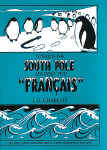|
The Translations
Towards
the South Pole aboard the Français
The First French Expedition to the Antarctic, 1903-1905
J-B. Charcot
|

|
|
<
< click the pic
to zoom |
The First French Expedition to the Antarctic set sail in August 1903 under the command of Jean-Baptiste Charcot, the 35-year-old son of a well-to-do neurologist. Charcot did not want to follow in his father’s footsteps, being more interested in a life at sea, but to please him he studied and graduated as a doctor in 1895. His father had died two years earlier, leaving his son with a quite reasonable fortune which gave him the chance to pursue his original interests in the sea and ships. During his disagreements with his father over his choice of career he would always say, when his father objected to his yearning to sail, ‘but why shouldn't I?’, and so was born the name of four of his ships - Pourquoi Pas? The next few years saw him sailing the waterways of France, Holland, England and around Ireland until in 1902 he sailed to Iceland and the Faroes with a commission from the French Naval Ministry. He reached the Arctic Circle and his taste for polar voyaging was established. On his return he commissioned a new vessel to be built, originally naming it
Pourquoi Pas? but in June 1903, renaming it Francais.
By this stage, Charcot, though an amateur, had become quite well known as a traveller and explorer, though Captain Scott referred to him - with possibly a touch of disparagement - as ‘the polar gentleman’. When Charcot first decided to sail to the Antarctic he consulted the Belgian, Adrien de Gerlache, who had recently returned from his own voyage in the Belgica. On 15 August 1903 the Francais set sail, with de Gerlache on board, having been persuaded by Charcot to join the expedition. Unfortunately this did not work out and de Gerlache left the ship at the first opportunity. Charcot had designed the ship in such a way that every man could have a private space of his own and he was particularly proud of his choice of comestibles - and wine - and the fact that fresh bread was baked three times a week.
His diary reveals a man of culture and sensitivity. His descriptions of scenery are lyrical and emotionally charged and his sensitivity to the local wildlife was often in stark contrast to many of the other polar explorers of the day. He charted new coasts, undertook scientific work in oceanography, bacteriology, geography, geology and above all meteorology.
This is a fascinating insight into a totally different style of Antarctic exploration and the reader will enjoy the delightful contrast between this expedition and others generally portrayed as more serious.
304pp, 253 x 174mm, hardback, cloth bound and blocked in two colours overall. Over 200 halftones, maps and drawings. £45.00/$85.00 REDUCED
TO £30.00
Order
|